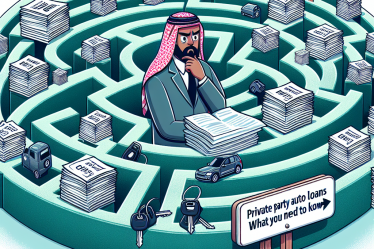
Key Insights to Keep in Mind
- Knowing your preapproval details helps you pinpoint your spending limit and monthly installment with confidence.
- Once preapproved, hammering out the final price and financing terms becomes a smoother negotiation.
- Preapproval isn’t a binding contract, so you’re free to shop around and snag the loan that best fits your wallet.
Getting preapproved is a solid strategy to stick to your financial plan and uncover attractive deals — even though it doesn’t guarantee the green light.
Decoding the Preapproved Auto Loan
Loans that come with a preapproval tag are those where lenders have given you a tentative thumbs-up, contingent on your finances staying stable until the deal is sealed.
Details like your interest rate, the loan amount, and repayment terms come bundled in the preapproval offer, equipping you to roll up to the dealership like a cash buyer — fully armed with clarity on your budget.
Negotiating a price at the dealership is far easier when you’ve got that preapproval backing you up and showing sellers you mean business.
To be sure you’re snagging the sharpest offer, peek at the dealership’s financing options. They might surprise you with a better rate, or you might stick with the loan you’ve already got locked down.
Pro Tip from Bankrate
Run an initial prequalification in the background — it won’t ding your credit score and helps map out your borrowing potential. Since it’s a soft inquiry, you can shop several lenders without penalty and weigh their terms before committing.
Ready to dive into car shopping? Preapproval arms you with a clear picture of what your finances can support. Barring any drastic changes in your income or credit, this offer lets you plug in the exact vehicle details when finalizing the loan.
Still, the preapproval isn’t gospel: lenders will verify your creditworthiness, income, and the vehicle’s condition before giving the final nod.
On the flip side, prequalification is more of a ballpark figure and less a firm offer. When you’re actively hunting for a ride, the real deal comes after submitting an official application — complete with a hard credit pull.
Mapping Out Your Preapproval Journey
The process flows similarly across most lenders and is the go-to route for many car buyers. Kick off your quest by scouting lenders compatible with your credit landscape, then gear up with some personal info.
- Check Your Credit Score. This number is a major player in your chances and the types of financing you’ll qualify for, so get a read on it ahead of time.
- Scout Lenders. If your credit’s in decent shape, zero in on lenders known for working with your score range.
- File for Preapproval. Toss out applications to at least three lenders on your shortlist. Evaluate the offers, making sure they fit your budget, then proceed with the best candidate to finalize your financing and drive off in your new vehicle.
The Perks of Having a Preapproved Auto Loan
With a preapproved loan, you get a leg up in comparing interest rates and budgeting monthly expenses, all while keeping your options open to jump ship if a better deal pops up.
Compare Lenders Effortlessly
Multiple preapproval applications let you survey a landscape of rates without hurting your credit profile, as long as you cluster those hard checks within a two-week window.
Note that some banks and credit unions tie their financing strictly to certain dealerships, which can shrink your vehicle choices and rule out private sellers.
Online lenders often skip these strings, so cast your net wide before house hunting. If a local dealer or private party tosses a stellar used car deal your way, having a flexible preapproval can be your secret weapon.
Score Better Interest Rates
Shopping with multiple lenders opens the door for competitive rates, especially if your credit is solid—some may roll out sweeter deals to woo your business.
Don’t overlook dealership financing either. With top-tier credit, you might qualify for in-house promos.
A preapproval is your crystal ball: it spells out the loan amount, rate, and term, helping you anticipate monthly payments and settle on what you can truly afford before hitting the lot.
Accuracy is king. Since preapprovals hinge on conditional approval, any mismatches between your application and actual paperwork can shift terms or lead to denial.
Your credit standing must remain stable from preapproval to final application. Taking on new debt, splurging on big purchases, or falling behind on payments can jeopardize your loan approval despite an earlier preapproval.
Cash Buyer Power in Negotiations
A crafty salesperson has tricks up their sleeve — keep your budget cards close and zero in on the car and features that catch your eye, rather than revealing what you’re willing to spend upfront.
Remember, focus on the out-the-door (OTD) price, not just the monthly payment. The OTD sums up the vehicle’s price plus taxes and fees — the full tally you’ll shell out.
Whenever possible, cover taxes upfront to dodge extra interest. Request a detailed fee breakdown and haggle to cut unnecessary costs.
Lock down the vehicle’s total price before diving into financing particulars. Dealers often spotlight low monthly payments to lure you—but those usually mean longer loan terms with more interest. Shorter terms with higher payments will save you more dough in the long haul.
Where to Hunt for Preapproved Auto Loans
Major banks, local credit unions, and online lenders all dish out preapproved auto loans. Start with your existing bank or credit union — they might offer sweet deals for loyal customers — then branch out to others.
Banks tend to have steeper requirements and higher rates unless your credit is stellar. Credit unions generally flaunt lower rates and friendlier rules, but joining them usually means opening an account first.
Online lenders are the easiest to qualify with, often welcoming borrowers with less-than-perfect credit, though their rates can lean towards the higher side.
To snag the best offer, scope out at least three lenders. This approach paints a clearer picture of your options and primes you to pick the most competitive deal.
Applications can usually be completed online, at branches, or even over the phone. Have your paperwork handy to streamline the process.
Paperwork Essentials for Preapproval
Before pressing “apply,” gather your financial toolkit. Lenders depend on these details to gauge your creditworthiness, and they tend to ask for:
- Official ID (proof of identity)
- Current address and phone contact
- Income and employment verification
- Proof of residency
- Auto insurance documentation
- Details about the vehicle, if relevant
Planning a down payment? You’ll likely need to show proof of those funds, too.
Jumping into the preapproved loan route can slice through the hassle and anxiety of buying a car. While it can’t promise you the exact model you want, it hands you a powerful advantage — walking in clear-eyed, knowing precisely what you can afford.

